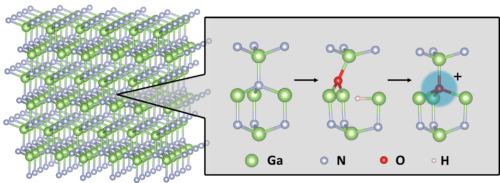‘Putting it all together’

Left: The bulk form of a perfect gallium nitride (GaN) crystal. Close-up, left to right: The perfect GaN structure and two forms with impurities where oxygen has replaced a nitrogen atom. (Schematic: Laura Nichols.)
Laura Nichols is always solving problems, whether that’s doing logic puzzles in her head or using supercomputers to study defects in semiconductor materials. She says, “Riding in the car, growing up, my dad would just toss out riddles and math problems for us to solve.”
But homework problems have never been enough for her — she wanted to create things as well. As a high school student, Nichols took classes in computational physics at a local university. There, she saw for the first time how science and computers could be used to solve real-world problems. She says, “Math is hard; physics is hard; computer programming is hard. But putting it all together was just such a fun challenge.”
Nichols went on to obtain her bachelor’s and master’s degrees in physics, including a stint working at FedEx analyzing data streams and predicting when technical problems might occur. Now, she’s a computational physics Ph.D. student on a Department of Energy Computational Science Graduate Fellowship (DOE CSGF) at Vanderbilt University. There she works with physicist Sokrates Pantelides making similar predictions in semiconductor materials.
Nichols and her colleagues study a material called gallium nitride (GaN). Most electronic devices, from phones to computer chips in cars, store information by passing an electrical current through silicon from one side of the device to the other. But silicon doesn’t work well in hot conditions or with high voltages. GaN, which is used in certain lasers and Blu-ray players, could be an alternative material for electronics manufacturers to use in these situations.
The downside of GaN, however, is that its atoms exist in a crystal lattice structure that often contains impurities — missing nitrogen or gallium ions, or including an oxygen where a nitrogen should be. Hydrogen atoms from the surroundings can fill in these spaces, keeping the material neutral and stable for a time. But when a device containing GaN is switched on, electrons start flowing through the semiconductor and hydrogen atoms can pop out of the lattice. The resulting defect then slows the electrons or stops them altogether, eventually degrading the semiconductor.
Nichols and her colleagues are modeling the rates at which hydrogen atoms are released from various defects. When the electrons lose energy, they release it in waves that cause GaN’s lattice structure to vibrate, releasing more hydrogen atoms and slowing the electrons even further. By using supercomputers to calculate the possible vibration patterns and relative probabilities of each, Nichols can analyze how quickly each type of defect releases hydrogen atoms. She then can compare this with experimental data to pinpoint which defect is causing degradation.
Once engineers understand the common defects and why they occur, Nichols says, semiconductor manufacturers could minimize them by altering GaN production conditions. She enjoys being a key part of that process. “It’s just really fun to me to bring that creativity to it,” she says. “You not only have to understand the calculus and the quantum physics and everything, but you have to sit down and come up with new solutions.”
Studying computational physics has also allowed Nichols, who has two young children, to work entirely from her home in Tennessee. Soon after her daughter was born in 2021, pandemic remote work options allowed her to complete a DOE CSGF practicum at Lawrence Berkeley National Laboratory without leaving her family. There, she designed computer vision approaches to characterize patterns in the roots of grass being grown for biofuel production. Understanding how the roots grow could help engineers determine the best types of soil and environments for producing these grasses at an industrial scale.
After completing her Ph.D. later this year, Nichols plans to take her problem-solving and computational skills to industry. She hopes to use data science to help businesses improve their processes and identify potential problems before they occur. She says, “Physics is great in that it lets you go really deep, but I want to pair the creative problem-solving with going wide and constantly learning new things in new fields.”
About the Author
The author is a freelance journalist covering biomedical, environmental and social science from Bozeman, Montana.





You must be logged in to post a comment.